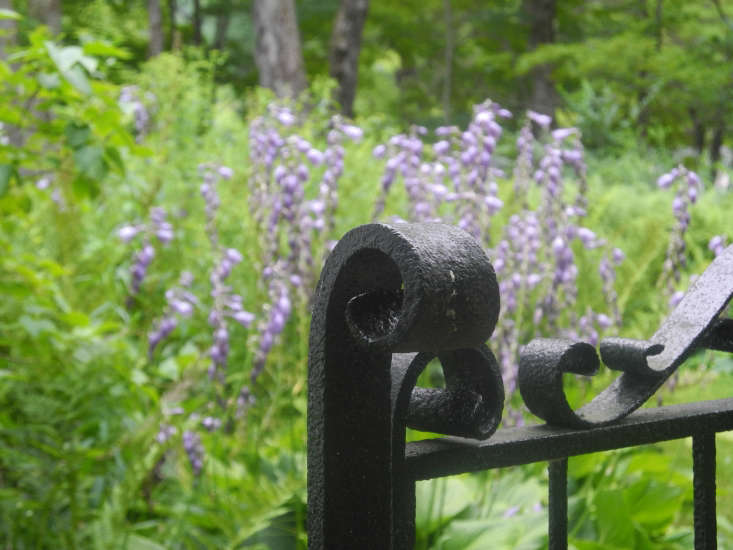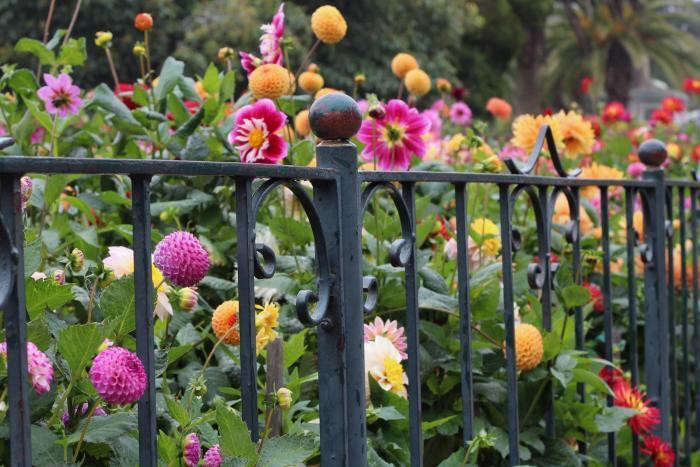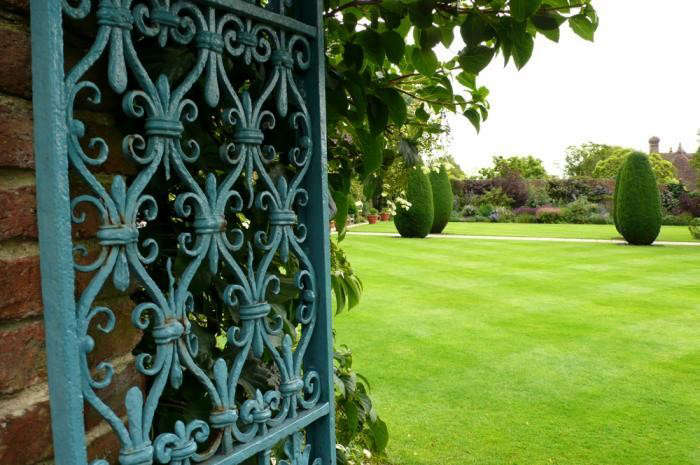During my stint living in London, I developed a crush. On wrought iron fences. Stately, strong, and secure, what’s not to like? But although it’s considered the king of fence materials, wrought iron comes with trade offs. The expense and style may not be for everyone.
Read on for everything you need to know about wrought iron fences to decide if they’re right for you:
What is wrought iron?

Above: Salvage yards can be a good source of antique true wrought iron fence work and gates. See more of this gate at A Poet’s Garden: Edna St. Vincent Millay at Steepletop. Photograph by Jeanne Rostaing.
Technically wrought iron is a very low carbon iron alloy (as compared to higher carbon, and more “fragile,” cast iron) that is very strong and malleable, historically making it the iron of choice for shaping. Due to production advancements and cost concerns, wrought iron is no longer produced en masse. The term wrought iron now generally applies to any iron (most typically mild steel) that is hammered, twisted, or bent into shape–or looks as if it has.
True wrought iron is a commodity today. Since wrought ironwork is forged by hand, small irregularities (and hammer marks) are usually apparent and valued as evidence of the smith’s craft. While there may be small iron smiths that still craft solid wrought iron work, it is hard to find and hard to finance.
What are the benefits of wrought iron fencing?
Above: Photograph by Marie Viljoen. For more, see 11 Garden Ideas to Steal from Buffalo, New York.
- Long Lasting:Wrought iron is an extremely durable material that will last for many years. Unlike wood, it won’t dry out, rot, warp, or deteriorate quickly.
- Strong:Wrought iron fencing is much stronger than other common fencing materials. Because wrought iron is so hard to break, it is better than many other fences for security purposes.
Above: Wrought iron’s strength and durability enable it to support plants (a built-in trellis), such as this Japanese anenome, without wavering or rotting. Photograph by Erin Boyle.
- Good Visibility: Wrought iron fencing designs have rails spaced apart for a thin profile that allows the backdrop to be the focus.
- Elegant, Classic Style:Arguably the most elegant fencing material available, wrought iron can be customized to be as simple or ornate as you like.
Above: Wrought iron looks great paired with plants of any size, shape, or color. Photograph by Michelle Slatalla.
Above: Not just for traditionalists, wrought iron fencing is available in modern streamlined silhouettes. Photograph via Mid South Iron.
- Pest Resistant:Wrought iron is invulnerable to the burrowing rodents and other damaging pests that can plague wood.
Are wrought iron lookalikes worth considering?
Buyer beware: imitations exist. Even if fencing is called wrought iron, it may have no iron content at all. This isn’t necessarily bad, as some materials with a wrought iron look are worth considering: namely, aluminum. Ornamental aluminum resembles wrought iron but at a much lower price point. It is lighter and easier to install, while offering durability and weather resistance. What do substitutes lack? The durability (can dent), the strength, and the patina of wrought iron.
Above: Hoover Fence offers a range of makes and styles of ornamental aluminum fencing with the look of wrought iron.
How much do wrought iron fences cost?
Top-of-the-line wrought iron is one of the most expensive fencing materials. Thanks to its longevity, the expense can be cost-effective over time. Because classification of wrought iron fencing is so varied, so is pricing. For manufactured off-the-shelf iron fencing, estimates range from $30 to $40 per foot (about twice the price of wood). Custom work can push the figure up tenfold (to $300 per foot). And, don’t forget installation. Wrought iron is heavy and requires solid footing and careful installation to make it last. The process can be labor intensive. Variables in cost include your geographical location, soil conditions, and customization required. And, as with any fence, remember to get underground utility lines marked to avoid undue complications.
How do you care for a wrought iron fence?
The good news is that with a little care, this durable and heavy fencing material will stand up to a lot of wear and tear for many years. Wrought iron will develop rust spots after some time, especially in damp or harsh environments. Usually from chips or scratches in the paint, these rust spots are easily managed and fixed by using sandpaper to remove rust and applying a protective layer of paint. An annual inspection and maintenance is recommended. And it is likely that you will need to fully re-paint every 10 to 15 years. If rust has formed, there is no need for concern. The thickness of the steel would require many years of being left unattended to structurally weaken the material (and, honestly, some like the look of the rust patina).
Above: To keep rust from forming, painting wrought iron is required. Paint will keep the tiny pits that can form in the metal from collecting substances that may cause them to corrode. For colors beyond the standard black, read our UK correspondent’s feature on Paint Colors for Iron Gates and Fences. Photograph by Kendra Wilson.
Wrought iron fencing recap:
Pros:
- Durable and long lasting
- Offers good visibility
- Strong
- Elegant and decorative
- Good for security (hard to climb, knock down, or break)
- Available in a range of styles
- Easily customizable
Cons:
- Expensive
- Open rail design doesn’t afford much privacy
- Requires maintenance for rust and corrosion
- Installation can be labor intensive
For more fencing ideas, see our earlier features:
- 10 Easy Pieces: Instant Fencing
- Hardscaping 101: Picket Fences
- Hardscaping 101: Gabion Walls
- Hardscaping 101: Hedges
- Hardscaping 101: Hog Wire
Finally, learn how to successfully design a fence for any landscape or garden project with our Hardscaping 101: Fences & Gates guide.















Have a Question or Comment About This Post?
Join the conversation